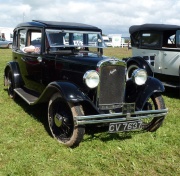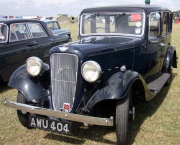Austin: Twelve



Note: This is a sub-section of Austin
General
- Austin: Heavy Twelve 1921-39 - (88,000 produced)
- Austin: Light Twelve-Four 1933-39 - (71,654 produced)
- Austin: Light Twelve-Six 1931-37 - (30,316 produced)
Heavy 12 Produced between 1921 and 1939. Around 88,000 were produced.
The Austin 12/4 was introduced by the Austin Motor Company in 1921. It was the second of Herbert Austin's post WW1 models and was in many ways a scaled-down version of the 20/4, introduced in 1919.
Initially available as a Tourer, by 1922 three body styles were offered, these being the four-seat tourer, the two/four-seater (both at 550 GBP) and the coupé at 675 GBP.
The car enjoyed success throughout the vintage era with annual sales peaking at 14,000 in 1927.
While the mechanical specification changed little (the engine increased from 1661 cc to 1861 cc in 1926), many body styles were offered with saloons becoming more popular as the twenties drew to a close.
The car continued in the Austin catalogue until 1935 and as a Taxi option until 1939. The last cars were produced for the War Department in 1940.
During the early thirties, the car began to become known as the "Heavy 12", to distinguish it from the other, newer, 12HP cars in the Austin catalogue - Light 12/4 and 12/6 - and received some updating. The artillery style wheels were replaced by wire spoked ones in 1933 and coil ignition replaced the magneto in 1935. The gearbox got synchromesh on its top two ratios in 1934. The body range was steadily simplified with the last of the fabric covered versions in 1931 and no open cars after 1934.
After the war the Austin 12 name returned to the Austin catalogue for a couple of years
Today, the Austin 12 is remembered as being virtually unburstable and is well catered for by the Vintage Austin Register in the UK and various other clubs in other parts of the world.
Austin 12/4
The Austin 12/4 was a car produced by the Austin Motor Company from 1933 until 1939.
To distinguish it from the earlier four cylinder Austin 12 it has become known as the Austin Light 12/4.
It was replaced in 1939 by a new model also called the Austin 12 keeping the same engine. The "12" in the name referred to the taxation horsepower, a British rating which controlled the annual taxation payable to use the car on the road.
In 1931 Austin introduced a new car, the 12/6, with a six cylinder engine, into the 12hp class. This was followed up in 1933 by the fitting of a 1,525 cc side valve, four cylinder engine with 24 bhp output into the same chassis. This was coupled to a four speed "crash" gearbox at first, but a new transmission with synchromesh on third and top speed appeared in 1934 and then also on second in 1935.
The chassis was conventional with semi-elliptic leaf springs on all wheels and rigid axles front and rear. Wire wheels were fitted until 1937 when they were replaced with pressed steel ones. At launch there was a choice of a pressed steel six-light (three windows on each side) saloon called the Harley and a two seat tourer.
A second saloon style with a boot, the Ascot, was added in 1934 and the Harley was dropped in 1935. In the same year the chromium plated radiator shell was replaced by one painted in body colour. The very early cars had their side lights mounted on the scuttle but these soon moved to the tops of the wings.
There was a major update in 1937 with the engine being moved forward on the chassis to improve passenger space. Other improvements included an adjustable steering column and the windscreen wipers moving to the scuttle from the top of the screen. The bodies became much more rounded and in 1938 an estate car was added to the model line-up and the tourer, which was still being built in the old style, was replaced by a four door cabriolet.
Austin 12/6
The Austin 12/6 was introduced by the Austin Motor Company in 1931 continuing in production until 1937. To separate it from the earlier, four cylinder, Austin 12, it has become known as the Austin Light 12/6.
There was among British car makers in the early 1930s a vogue for small capacity six cylinder engines and the 12/6 was Austin's example. The side valve engine was new and initially of 1,496 cc capacity.
It was supplemented by an increased 65.5 mm bore, larger capacity 1,711 cc option from 1934.
Initially there was a three speed transmission but a four speed was an option from 1932 and became standard in 1933. This gained synchromesh on third and top speed in 1934 and on second in 1935.
The chassis was conventional with semi-elliptic leaf springs on all wheels and rigid axles front and rear. There was a range of bodies on offer with initially a fabric bodied saloon and a pressed steel six-light (three windows on each side) saloon called the Harley.
For 1932 the short lived fabric saloon was dropped but open two and four seat tourers were added. A further saloon with a boot, the Ascot, was added in 1934 and the Harley was dropped in 1935. Also in 1935 the chromium plated radiator shell was replaced by one painted in body colour.
A Sports variant was added in 1933 with a lowered chassis and higher compression engine. There were tourer and saloon options with sloping radiators, the closed cars having four-light bodies.
The chassis was shared from 1933 with the four cylinder Austin 12/4.



















































